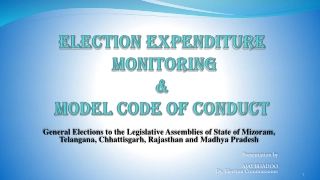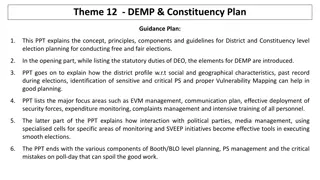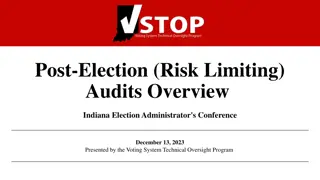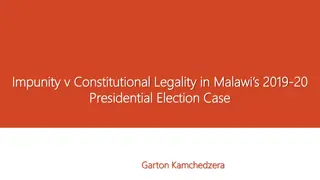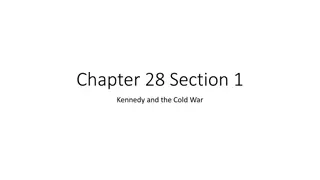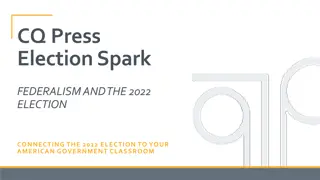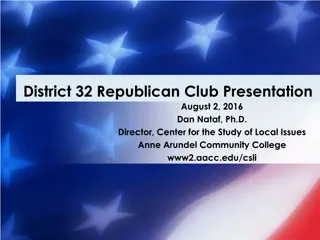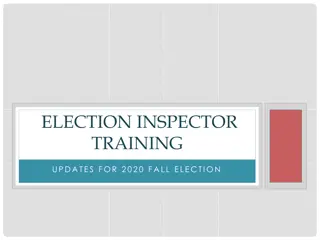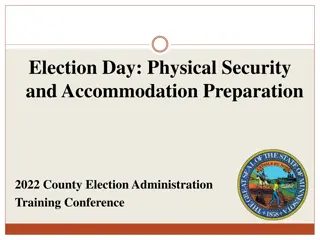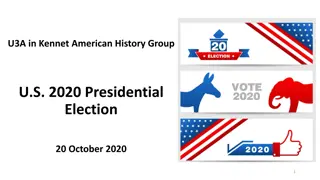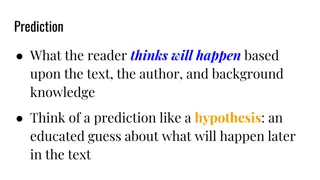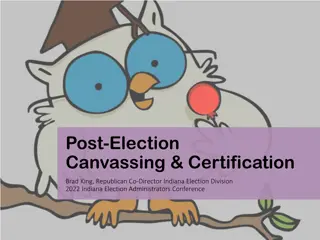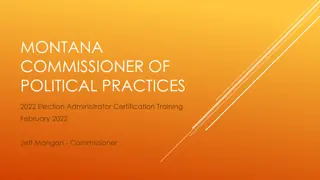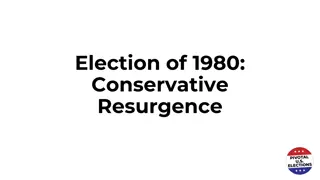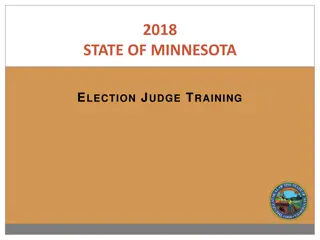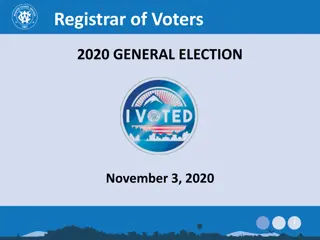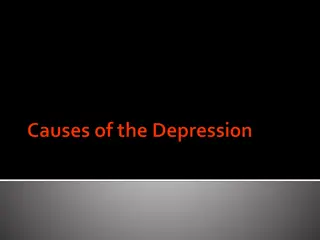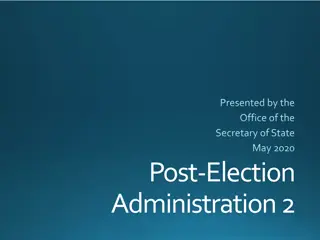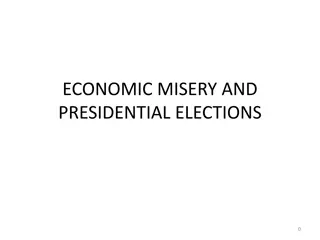The Math Behind Presidential Election Predictions
This project explores using Bayesian Statistics to predict presidential elections, inspired by Nate Silver's successful methodology. The focus is on improving accuracy by incorporating outside data alongside polling results. The significance of this approach lies in its scientific rigor and transparency compared to traditional election predictions. The project involves both predictions and a blog where insights on election dynamics are shared. Methodologically, the project uses Excel and normal distribution for predicting nomination outcomes in the complex primary process.
Download Presentation

Please find below an Image/Link to download the presentation.
The content on the website is provided AS IS for your information and personal use only. It may not be sold, licensed, or shared on other websites without obtaining consent from the author.If you encounter any issues during the download, it is possible that the publisher has removed the file from their server.
You are allowed to download the files provided on this website for personal or commercial use, subject to the condition that they are used lawfully. All files are the property of their respective owners.
The content on the website is provided AS IS for your information and personal use only. It may not be sold, licensed, or shared on other websites without obtaining consent from the author.
E N D
Presentation Transcript
The Math Behind the Presidential Election Brittany Alexander, Dr. Leif Ellingson
My project My project is based on the work of Nate Silver who predicted the outcome of the 2008 election with 98% accuracy, and 100% accuracy in 2012. Nate Silver, like most political science statisticians is not an academic researcher. He didn t disclose much about his model and didn t form a final prediction until the day of the election The first step was testing a theory of using the results of previous states to predict the primary outcome in future states. Now I am trying to test the theory that you can use Bayesian Statistics to predict a presidential election with higher accuracy than a simple average of polls
Why Bayesian Statistics? Bayesian Statistics considers likelihood and allows the inclusion of outside data while still using data from that state It provides a level of choice in a prior to include information not reflected in the polls or results It was something that I could study given that I had a limited knowledge of statistics as an undergraduate student It appeared to work for Nate Silver in 2008 and 2012.
Why my project matters People who predict elections like Nate Silver don t always have formal training in Statistics Most of the time information on how the prediction is formed is not revealed In Academia, election statistics are usually studied after instead of during the process Most statistics in political science research are basic My goal was to approach my project scientifically
What I am doing My project really has two parts: the predictions and the blog. I have a blog where I write about my feelings about the election and how math and sometimes economics are playing a role. My predictions are final when submitted I don t edit any of my posts I use a blogger account so that there is a third party record of my information I disclose my personal opinions Every prediction is made at least 48 Hours in advance. I disclose the mean, standard deviation and confidence interval
Methodology for the Nomination Process I used excel to make predictions After Iowa and New Hampshire I used previous results from elections as my prior This is much more difficult than predicting a general election because there are multiple candidates and complicated rules for assigning delegates I used a normal distribution to simulate likelihood All elections were called at least 48 hours in advance So far I have not been able to find a good comparison to judge accuracy
Methodology for the Nomination Process Continued I had clear cut rules on when and how I would predict set before any votes were cast I tried to balance making decisions on opinion based and data based factors After Super Tuesday I realized that there were flaws in how my model handled candidate dropouts and the limited availability of states for the prior I believe a better model would be to create a prior based on exit poll data to create a better fitting sample
Results for the Nomination Process I had 79.6% accuracy I used second choice data to normalize the probabilities This overestimated the more traditional candidates like Cruz and Rubio, and caused an underestimation of Trump The second choice data suggested that Trump would not gain supporter over the process but this was not the case Trump did not have any of the normal indicators for a nominee (campaign funding, endorsements, support of media outlets) Further testing is needed to see how this kind of model would work in other years
Methodology for the Presidential Election I am using a Gaussian conjugate analysis on poll data My prior is national polls for swing states, Texas/Nebraska polls for Red States, and New York/California Polls for Blue States I am using Anaconda (a python platform) with Scipy and Numpy to make my calculations I download CSV of poll data from Pollster , and clean them to make the program able to read it. The results are added to a file. Only poll results taken after July 1st, 2016 are considered. July 1stwas chosen because it was after the candidates were decided and media coverage of the general election was beginning
Methodology for the Presidential Election Continued Priors are chosen based on the political stance of a state (Red vs Blue), and the demographics My Priors are Nebraska for Midwest Red States, Texas for the Red south states, New York for northern blue states, California for western blue states, and National Polls for swing states For states that serve as a prior for their category data from a similar state will serve as the prior My predictions go final on November 5that Midnight Information on predictions from Five Thirty Eight, 270 to Win, and Princeton Election Consortium will be pulled on the 6thto allow for a better comparison of accuracy If something changes after Saturday but before Tuesday I may add on update
What I consider Swing State My definition of a Swing State is any state that the outcome was hard to determine at any point of the process, and has a reasonable chance of a 2 or more outcomes My swing states are: Arizona, Colorado, Florida, Iowa, Nevada, New Hampshire, North Carolina, Ohio, Pennsylvania, Utah , Virginia, Wisconsin
What I learned so far Previous states are fairly good predictors of future states in a sequential primary, but further study is needed with a more complicated model Donald Trump doesn t fit the traditional candidate mold. His supporters are incredibly enthusiastic and I plan to break down how this happened by breaking down the data from both the primary and general election because it could change how future elections work Methods to find and produce better fitting priors should be studied Advanced Statistical methods aren t used in political science research statistics. I plan to get my Ph.D. in Statistics and focus on political science statistics in my career.
What will happen on November 8th? Hillary Clinton will probably win the presidency decisively. The senate is a tossup. I am not studying it in depth but the polls look like the majority could go either way. General Election Turnout may not increase like the turnout in the nomination process, but the turnout could still be record breaking Gary Johnson, may break 5% and the libertarian party may get major party status There is the potential that this election may be hard to predict and my model and the model of others may not achieve 100% accuracy
Looking Forward to 2020 Colorado may not be considered a swing state and may turn blue Utah, Arizona, and other red states who were at one point at risk of swinging will probably be fine in 2020 assuming the Republican nominee is less controversial. I plan to try to use more advanced methods to predict again


